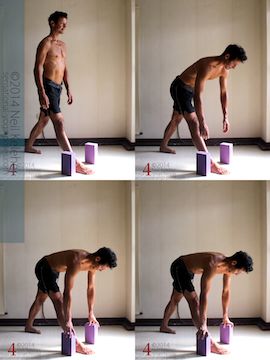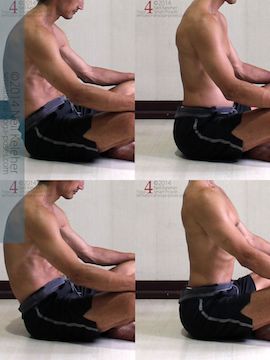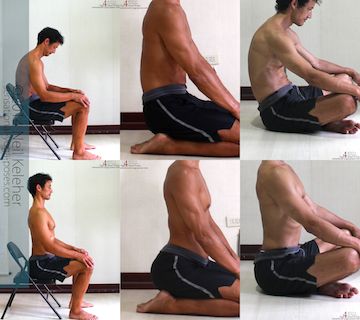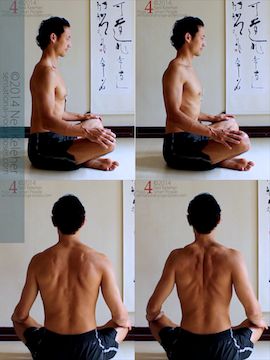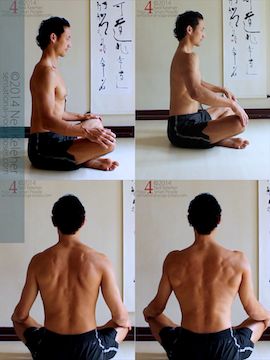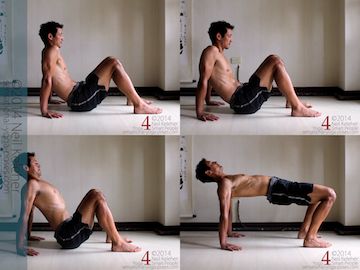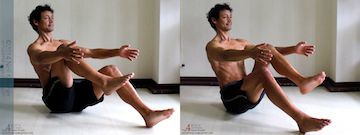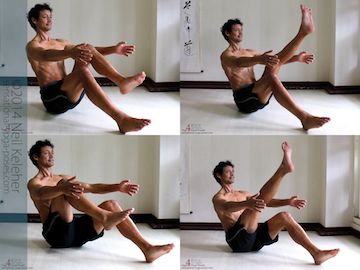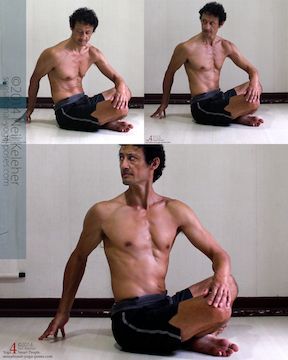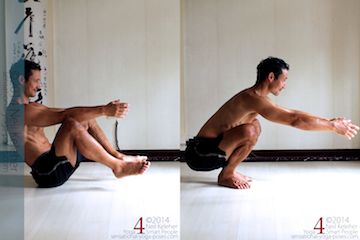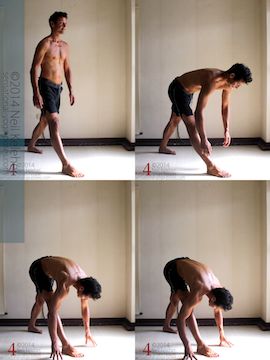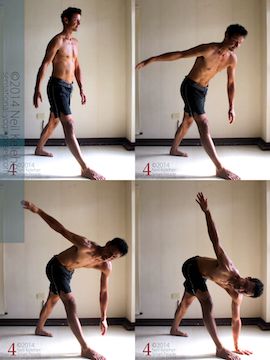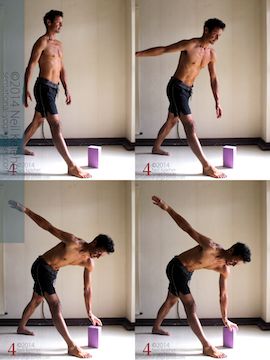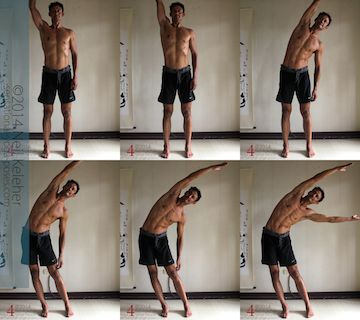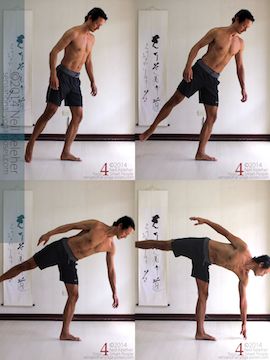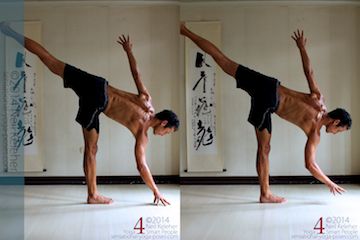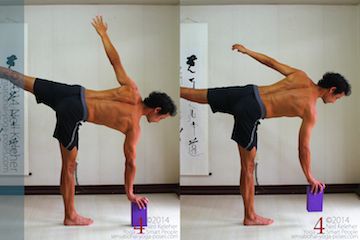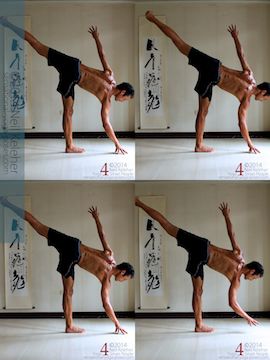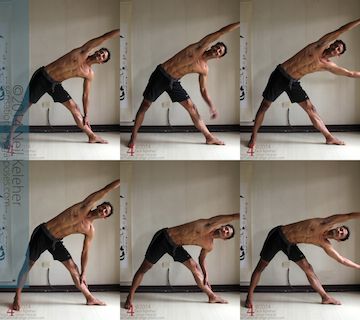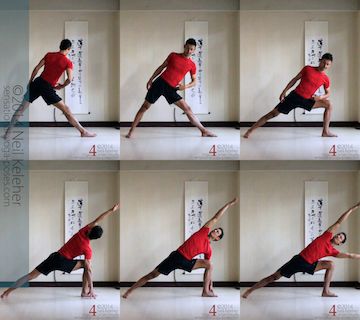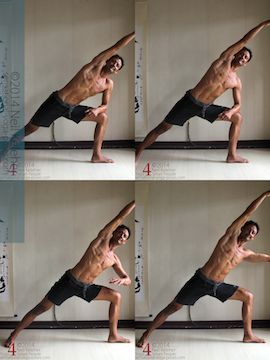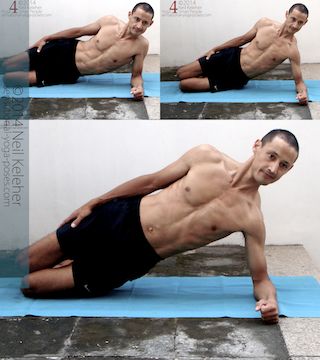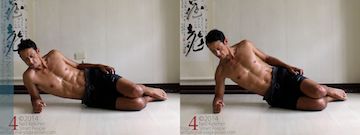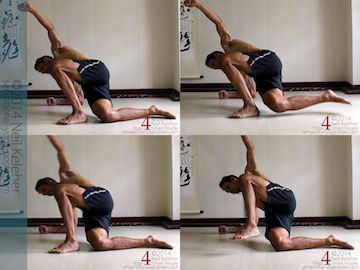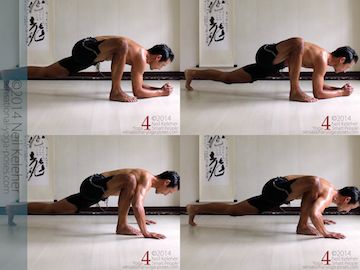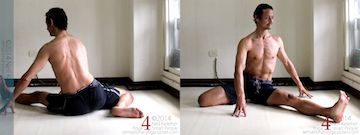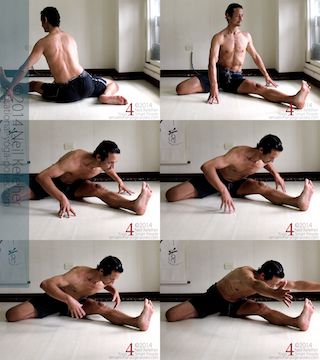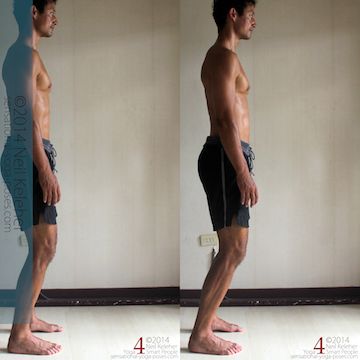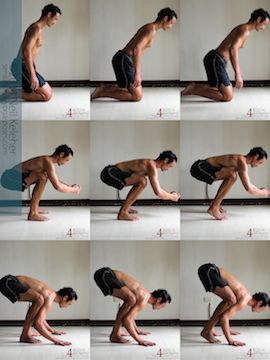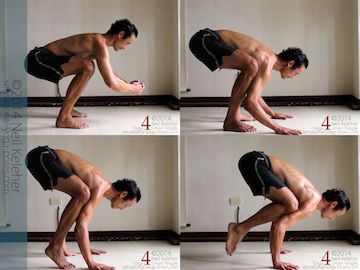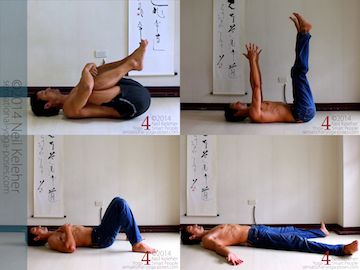All exercises are non-ballistic, that is slow and smooth.
- Even for small ranges of motion the exercises are repeated with a slow, smooth and rhythmic tempo.
- Take five seconds or more to do each phase of the movement.
- If I was simply instructing inhaling and exhaling then take five seconds or more to inhale and five seconds to exhale with a smooth transition between each.
In any case, make the movements slow and smooth and continuous.
All exercises have a directed focus.
- While doing each exercise, focus on the changes in sensation that the movement generates.
- This is to generate better body awareness and control and to make the movements easier.
If a movement involves placing the hands on the floor but you can't reach the floor then use props.
- In standing poses place your hands on props so that you can use your arms to support your body at the bottom of a movement.
- In seated poses you may need to raise your hips so that you can bend forwards with the help of gravity. Ideally, if you raise your hips, then place blocks under your knees also so that you can press your knees down when required.
- If the instruction is to grab a foot, then use straps if you can't reach the foot, or grab the ankle or shin or thigh.
Understand what you are trying to do in each pose.
- If you understand the general intent of the pose you may find it easier to create work arounds if your body doesn't allow you to do it as I've described.
- The instructions include modifications. See if you can figure out why each modification is used so that you can begin figuring out your own modifications when required.
Know the destination but focus on the journey.
In the exercises below that means focusing on feeling your body and responding to what you feel.
The following is an introduction to some basic exercises. The intent is to introduce you to the basic choreography or framework without bogging you down with detailed explanations.
The first exercise focuses on repeatedly bending the spine backwards and then allowing it to return to neutral.
Relaxed with spine bent forwards.
Sacrum lifted and lumbar spine bent backwards.
Sitting relaxed with spine bend forwards.
Sacrum lifted with lumbar and thoracic spine bent backwards.
While sitting cross legged and keeping your torso upright:
- Slowly lift your sacrum so that your pelvis rolls forwards.
- Then move your sacrum downwards (or let it sink downwards) so that your pelvis rolls backwards.
Repeat a few times while focusing on feeling the movement of the sacrum and pelvis.
Continue repeating the same movement but expand your awareness to include your lower back.
- As you lift your sacrum feel your lumbar spine bending backwards.
- As you lower the sacrum feel your lumbar spine relaxing and bending forwards.
Once you have a feel for bending your lower back backwards and forwards, try to bend the thoracic spine backwards and forwards also.
- As you lift your sacrum first bend your lumbar spine backwards then continue the action upward the spine and bend your thoracic spine backwards.
- Then as you sink your sacrum downwards allow your lumbar and thoracic spine to bend forwards.
Upright spinal back bending and forward bending can be practiced while sitting in a chair, kneeling, sitting cross legged or while standing (not shown.)
Sitting in a Chair (top to bottom): spine relaxed, then spine bent backwards.
Kneeling: spine relaxed then bent backwards.
Cross Legged: Spine relaxed then bent backwards.
The next exercise is an introduction to isolating, feeling and controlling the position of the shoulder blades relative to the ribcage. This next exercise focuses on Retraction, drawing the shoulder blades inwards.
Scapular Retraction Exercise:
With chest lifted, move the shoulders back so that the shoulder blades move inwards, towards each other.
While sitting cross legged with your arms hanging down by your side, lift your chest. Keep it lifted.
- Move your shoulders back relative to your chest
- Then relax them so that they return to neutral.
Repeat this action a few times, then focus on feeling the inside edges of your shoulder blades.
- As you move your shoulders back feel (or imagine you can feel) the inside edges of the shoulder blades moving inwards.
- Then as you let your shoulders return to neutral feel the inner edges of the shoulder blades moving away from each other.
If you have trouble keeping your chest lifted:
Relax your chest after your shoulders return to neutral.
Then prior to retracting the shoulder blades again, lift it.
This next exercise focuses on Protraction, drawing the shoulder blades outwards.
Scapular Protraction Exercise:
With chest lifted, move the shoulders forwards so that the shoulder blades move outwards, away each other.
While sitting cross legged with your arms hanging down by your side or on your thighs:
- Lift your chest.
- Move your shoulders forwards without dropping or sinking your chest.
- Then relax so that they return to neutral.
- Relax your chest.
Repeat this action a few times, then focus on feeling the inside edges of your shoulder blades.
- As you move your shoulders forwards focus on pulling the inside edges of the shoulder blades outwards.
- Then as you let your shoulders return to neutral feel the inner edges of the shoulder blades moving towards each other.
Avoid contracting the pectoralis major (the large chest muscle) when spreading the shoulder blades.
The next exercise focus on the shoulders, spine and legs first in isolation then together as an integrated action.
For Table Top:
Start with shoulders relaxed.
Retract shoulder blades.
Then lift and open chest (bend thoracic spine backwards).
Then lift the hips.
If you have trouble with any of these steps, then practice that step in isolation. i.e. for retraction practice relaxing shoulders then retracting shoulder blades. Repeat until you are comfortable with the action.
While sitting, place your hands on the floor behind you with fingers pointing forwards.
Bend the knees and place the feet flat on the floor about shoulder width apart in front of you.
- Retract the shoulder blades. Feel your hands press into the floor.
- Relax the retraction.
Repeat a few times then:
- Retract the shoulder blades
- Bend the lumbar and thoracic spine backwards (you can lift the sacrum as you do so)
- Then relax both actions
Repeat a few times then:
- Retract the shoulder blades
- Bend the lumbar and thoracic spine backwards
- Press the feet down to lift the pelvis a few inches off of the floor.
- Lower the pelvis and relax
Repeat a few times then:
- Lift the pelvis gradually higher while keeping shoulder blades retracted and chest open.
- Lower and repeat a few times, then hold.
While holding see if you can reach your chest/front ribs backwards, away from your pubic bone and towards your chin.
This next exercise focuses on active hip flexion one leg at a time while balancing on the buttocks.
You can also think of this as bending the hips forwards.
Sitting upright, lift the chest.
Lean back and reach the arms forwards (keeping the chest open.)
Lift one knee and pull it back towards the chest (without collapsing the chest.) Lower the leg and repeat with the other leg.
While sitting upright with knees bent and feet on the floor hip width apart reach your arms forwards and then lean your torso backwards keeping your spine "straight."
While balancing on your butt with both heels on the floor:
- Lift one foot and pull the knee to the chest (keep the other foot on the floor.
- Then lower the leg.
- Lift the other foot, pull the knee to the chest (while keeping the chest lifted)
- Then lower the leg.
Repeat 3 to 5 times for each leg, alternating legs each time.
Rest for a few breaths and then do the same exercise but straighten the knee after pulling it towards the chest.
Sit upright with chest open.
Lean back keeping chest open.
Lift one knee and pull it towards your chest using your hip flexors.
Keep the knee pulling backwards, straighten the knee. (Then release and repeat on other side.)
- Lift one knee
- Straighten that knee
- Put the foot down
- Repeat with the other leg.
Repeat two or more times on each side.
Memorize the feeling at the front of the thigh and hip when pulling the knee to the chest.
Memorize the feeling of the muscles at the front of the thigh when the knee is straight
This next exercise focuses on assisted spinal twisting.
An option while twisting is to bend the spine forwards, then bend it backwards.
While bending forwards you can relax from the twist a little.
While bending the spine backwards work at deepening the twist.
Sitting cross legged with your hands on your waist or together in prayer in front of your chest, turn your ribcage to the right.
Hold the twist:
- gradually bend your thoracic and lumbar spine backwards and deepen the twist.
- slightly bend your thoracic and lumbar spine forwards and relax the twist a little.
Repeat a few times then switch the cross of your legs so that the other shin is in front and repeat the twist to the other side.
When twisting to the right:
Focus first on using your right arm to pull the right side of your ribcage backwards each time you bend the spine backwards.
Then focus on your left hand. Use your left hand to pull the left side of your ribcage forwards a little bit more each time you bend the spine backwards.
The next exercise is to from a seated position to a squat. This is simply a way to transition from sitting to squatting (or standing).
Balancing on the butt with the hands reaching forwards between spread knees, rock forwards into a squat.
(If you have difficulty, try sitting on a yoga block and then rock forwards onto your feet.)
- With feel lifted and knees spread apart reach your arms and chest forwards between your knees and try to roll to a squat.
- If you need to, start on your back and use momentum to first roll up to sitting a few times, then try rolling up onto your feet.
- You can also hold on to your knees when rolling up.
Work towards the point that you can slowly roll from your hips to your feet.
Rather than holding the "triangle forward bending" position, this exercise involves bending forwards and standing back up.
While the eventual goal is to be able to touch the hands to the floor, what is more important in this exercise is:
- Being able to slowly and smoothly bend forwards (take 5 seconds or more to bend forwards) and
- Slowly and smoothly stand back up again (5 seconds or more!)
Standing with one leg forwards and the other leg back with both knees straight:
Slowly bend forwards and touch hands to the floor if possible. Then stand back up (not shown).
For this exercise stand with one leg forwards and the other leg back.
Turn the back foot outwards enough that you can keep your back foot flat on the floor.
Keep both knees straight and turn your hips square to the front.
- Bend forwards while keeping both knees straight and both feet flat on the floor.
- If your hands touch the floor, slowly bend the elbows to sink the chest deeper.
- Relax the arms and then stand back up again.
Repeat 5 times or more.
If you can't reach the floor then place blocks on the floor beneath your shoulders on either side of your front foot, and place your hands on the blocks as you bend forwards.
Next, add a twist as you bend forwards.
As you bend forwards, turn your ribcage towards the front leg side.
Reach the back-leg hand down and the front-leg hand up.
Touch the floor if possible with the bottom hand. Then stand back up (not shown.)
- Keeping the same leg position as you bend forwards turn the ribcage to the same side as the front leg.
- Reach the bottom hand down and the upper hand up.
- If possible touch the bottom hand to the floor.
- Pause for a moment at the bottom then stand back up, turning to face the front as you do so.
Repeat five times or more.
If you can't reach the floor when bending forwards and twisting, you can use a yoga block.
The next exercise involves balancing on one foot while bent forwards.
While bending forwards with hands on the floor (or on yoga blocks), shift weight to one foot.
Lift the non-weighted foot.
Then lift both hands an inch off of the floor.
The key in this pose is stabilizing the standing foot, ankle and hip.
Stand with feet hip width or shoulder width apart, toes and knees pointing straight ahead. Bend forwards.
- Shift your weight to your right foot. Make the foot and ankle feel strong.
- Lift your left foot. Pull the foot forwards rather than letting it reach back.
- Keep the standing leg hip stable then lift both hands.
- Balance (and breathe) for a few moments, then move back to center. Repeat two to three times on each foot, switching feet each time.
If you hands don't touch the floor then place your hands on blocks high enough that you can use your shoulders to press your hands down.
Another option is to bend the knees and over the course of your daily practice, work at doing this exercise with gradually straighter knees.
The basic squatting exercise that I use is to lower from standing upright to a squat position with thighs horizontal.
Pause, then slowly stand back up.
Another variation is to lower to half way, hold then lower to a full squat. Then lift to the half way position. Then stand.
First row, from standing, squatting to the thighs horizontal position.
Second row, from a relaxed deep squat, lifting up to the half squat position.
Notice in the bottom middle picture, I lengthen my spine prior to lifting the hips.
Start in a standing position with feet hip width and with knees and toes pointing straight ahead
- Reach the hips back and bend the knees.
- Reach the arms forwards and tip the pelvis/ribcage forwards to stay balanced.
- Lower to thighs level and hold.
- Then stand up slowly.
- Repeat.
Next:
- Lower to the half squat position.
- Then lower all the way down and relax.
- Lift back up to the half way position.
- Lower all the way down again.
Repeat 3 or 4 times, then from the final half squat position slowly return to standing.
Reach the hips and knees back so that when viewed from the side the knees do not project past the toes. To counterbalance tilt the pelvis and chest forwards and also reach the arms forwards.
If your feet are active and strong while squatting this "adjustment" may be less critical.
In standing side bend both the spine and the hip joints are bent to the side. However, for better body awareness (and muscle control) the spine is bent sideways first, then the hips.
Standing side bend.
One way to enter standing side bend is to first reach one arm up and lengthen that side of the body.
Then bend the spine to the opposite side.
Then push the hips in the opposite direction.
You can then reach to the side with the bottom hand.
Stand with feet hip width, toes and knees pointing straight ahead, knees straight.
- Reach the right arm up. (Lift the shoulder. Lengthen the right side of the body and arm.)
- Then bend the lumbar spine and thoracic spine to the left.
- Then push the hips to the right.
- Then Reach the left arm to the left.
While holding the pose:
- Press the thighs outwards to activate the outer thighs. At the same time widen/protract the shoulder blades. Then relax these actions.
- Next pull the thighs inwards to activate the inner thighs. At the same time retract the shoulder blades. Then relax.
- Repeat 3 to 5 times.
If you have trouble pressing the thighs apart or pulling them together while in standing forward bend then try the action first while standing upright.
When widening the thighs (or pulling them together), keep the feet stable.
Feel like you are trying to pull the thigh bones towards each other or away from each other to activate either the inner thigh muscles or the outer thigh muscles.
The goal for this exercise is to slowly place the hand on the floor. Then slowly lift the hand and pause prior to standing up under control.
With the standing foot turned out, shift weight onto that foot.
You can pause here and focus on balancing.
Then tilt the pelvis in order to touch the bottom hand to the floor.
You can then focus on lifting the other leg higher.
To get into half moon pose:
- Turn your left foot out 90 degrees.
- Stand on your left foot with the right foot lifted.
- Turn the pelvis to the front.
- Slowly touch your hand to the floor. For bonus points reach the right leg and right arm upwards towards the ceiling.
Hold for a few breaths then:
- Lift the hand an inch off of the floor. Pause.
- Slowly stand up.
Half moon pose.
Prior to lifting the hand make sure your weight is centered over your standing foot.
You can also make sure that the foot and ankle are stable.
Then try to lift the hand.
Repeat to the other side.
If you are using a yoga block as a prop for half moon, I'd suggest holding it in the hand as you reach the hand towards the floor. Gradually reduce the height of the block as you get more comfortable with this exercise to the point that you no longer need the block.
Another option, if you have trouble touching the floor, is to bend the standing knee.
Sometimes I'll include a weight shift as part of this exercise.
With hand on the floor in half moon pose, first shift weight towards the hand.
(Look at the change in angle of my standing leg in the top right picture.)
Then shift weight back entirely onto the supporting foot.
Then lift the hand. Then put the hand down again and repeat.
With weight on the right foot and right hand on the floor shift weight towards the hand (to the right) so that the hand presses down more.
- Then shift weight left so that body weight is centered over the foot. (The hand should feel more relaxed.)
- Then lift the hand.
- Then put the hand down again. Shift weight partially onto the hand.
Repeat 3 or more times.
To stand, shift onto the standing foot, make it stable, lift the hand, then stand while keeping body weight centered over the standing foot.
Repeat on the other side.
In triangle pose, the exercise again involves stabilizing a leg so that the arm can be lifted and then making the arm strong so that the leg can be relaxed.
It is while the leg is relaxed that you can sink the ribcage lower to deepen the stretch.
With the hand resting on the leg, make the arm strong to support the weight of the ribcage so that the (left) leg can relax.
Prior to lifting the arm, brace the left leg by pushing down with the front of the foot and squeezing the side of the buttock. Then reach to the side with the left arm.
When you put the hand on the leg again, brace the arm and relax the leg. Then gradually bend the elbow to allow the ribcage to sink down.
Brace the leg again prior to lifting the arm.
Step your feet about a legs length apart. Turn your left foot in slightly. Turn your right foot out 90 degrees.
- Drop your left hip so that your torso leans to the left. Rest your left hand on thigh or shin.
- Keep your pelvis and torso facing the "front".
- Make the left arm strong so that it feels like your arm is supporting the weight of your ribcage. Relax the left leg while the arm is strong.
- Prior to lifting the arm, make the left leg strong. Press the front of the left foot down. Squeeze the left buttock.
- Lift the left hand and reach it to the left.
- Then put the hand back on the leg. Make the arm strong and the leg relaxed. Bend the elbow to allow the ribcage to sink downwards towards the thigh.
Repeat the arm lift a few times then come up.
Repeat on other side.
If your torso sinks low enough,you can place the hand on the floor instead of the leg.
Each time you put the hand down, make the arm feel strong, even as you bend the elbow to help lower the ribcage.
When you brace the leg, try to roll the top of the hip (the left side) back a little. Try to keep the ribs reaching away from the pelvis and your ears away form your shoulders so that your spine feels long.
As an alternative to resting the hand on the shin or thigh, place it on a yoga block, chair or table instead.
Side angle is another posture in which you can practice "swapping foundations."
To enter side angle pose, turn one foot in and the other foot out 90 degrees.
Drop the hip on the turned out foot side.
Then bend the knee while maintaining the sideways tilt of the pelvis.
Place the arm on the thigh or hand on the floor.
Brace the leg prior to lifting the arm.
When the arm is on the thigh or hand is on the floor, brace the arm so that the leg can relax.
In side angle pose, when the arm is resting on the thigh, or the hand is on the ground, you can use the arm to support the weight of the ribcage so that the bent knee leg can relax.
Prior to lifting the arm you can make the leg strong so that it supports the upper body. You can then let the arm relax and then lift it and reach it to the side.
Stand with feet slightly further apart than in previous pose.
- Turn left foot in slightly. Turn right foot out 90 degrees.
- Drop the right hip so that the pelvis is angle downwards from left to right.
- Bend the right knee so that shin is parallel and thigh approaches the horizontal. Keep the pelvis tilted to the right.
- Place elbow on thigh and use the shoulder to lift the ribcage away from the thigh.
- Press down with front of the right the foot and squeeze the side of the right buttock so that the right leg feels strong and stable.
- Feel the arm relax as the leg is activated and then reach arm out to the side.
- Then put the arm back on the leg and relax the leg. Then repeat.
With forearm resting on the thigh, use the shoulder to press the arm down and the ribcage up. (In picture 1, shoulder is relaxed. In picture 2 the left shoulder is active and pushing the ribcage up.)
Brace the leg prior to lifting the arm, then reach the arm out to the side.
With the arms reaching out the side, weight is added to the pose.
This makes the bent knee leg work harder.
To make the pose a little more challenging try placing the hand on the floor either outside the foot or inside.
Again make the arm strong when the hand is on the floor to support the ribcage. Make the leg strong (without lifting higher) in order to reach the arm.
If you can't go deep in this pose then stand with the feet slightly closer together.
In this instance, lift the hip higher so that you keep the shin vertical.
See if you can still create a straight line along the top side of the body i.e. with right knee bent: left leg, left side of the body left arm all in one long line.
This exercise builds further on the idea of stabilizing one body part so that another body part can relax.
Modified Side Plank Position:
Use the shoulder to lift the ribcage.
Then use the thigh to lift the pelvis.
For side plank lay on one side with the supporting elbow bent and on the floor and both knees bent. Point the shins behind you so that thighs are more or less in line with your torso.
Protract your bottom shoulder blade so that the elbow presses down into the floor and the ribcage lifts up.
Then relax the shoulder and let the ribcage sink back down.
Repeat a few times getting a feel for the shoulder action.
Start with the shoulder relaxed.
Then use the shoulder to push the ribcage up, away from the floor.
Then relax and repeat.
Next, add the hips.
- First lift the ribcage using the arm,
- Then lift the pelvis by pressing the bottom knee into the floor.
- Lower, relax and then repeat.
What was the feeling in the right thigh when you lift the pelvis? What was the feeling in the thigh when you lowered the pelvis. Was the thigh active or relaxed?
Ideally with the pelvis on the floor your right thigh was relaxed. Then as you pressed the knee down to lift the pelvis you felt (or will learn to feel) the muscles of the outer right thigh activating.
If you have trouble feeling the difference between when your thigh is activate and when it is relaxed try slowly pressing your knee down with your pelvis on the floor.
Notice the tension that occurs in your leg as yo press the knee down.
Then slowly relax. And notice the tension disappear.
This next side plank variation involves shifting the base of support from one leg to the other. When one leg is supporting the pelvis and keeping it lifted, the other leg can be lifted off of the floor.
Shift weight forwards, lift back leg.
Shift weight back, lift front leg.
In either case make the non-lifting leg strong prior to lifting the other leg.
Next, lift the ribcage, lift the hips. Lift the left leg then place the left foot on the floor in front of your right thigh.
Shift your weight forwards and back a few times: forwards onto the left foot and then back onto the right knee.
Then:
- Shift weight forwards, make left foot strong and lift your right foot.
- Then put the foot down.
- Shift weight back, make the right leg strong and lift the left leg.
- Then put the foot down.
Repeat a few times keeping the hips lifted.
Then lower and relax and repeat parts 1 and 1a on the other side.
With this exercise the focus was on weight shifting, then making one leg strong so that you could lift the other leg.
You don't always have to weight shift in order to switch foundations.
As an example, in triangle and side angle the weight didn't shift. Instead you made the leg strong or the arm strong.
Be aware that sometimes you need to shift weight prior to switching foundations.
Sometimes you don't.
Low lunge can be used to stretch the hip extensors. Here we'll be learning to activate the front leg and then relax it. You may find this makes it easier to sink the pelvis.
The hip extensors are the single joint muscles that work on the back of the hip.
With elbows on the floor in low lunge work at sinking the hips.
With hands on the floor in push up position, gradually deepen the elbow bend to sink the chest and hips.
Start with your right leg forwards and left leg back with left knee on the floor. Bend the right knee and sink the pelvis.
Move the right foot forwards (or backwards) so that when viewed from the side, the right shin is nearly vertical (with the knee just slightly ahead of the front of the ankle).
Pull the head forwards so that the neck feels long.
- Place the left elbow on the floor, then the right one.
- Make the front leg feel strong. Then relax it.
- Let the pelvis sink deeper each time you relax the front leg. (Lift the back knee to add weight to the pose. )
Repeat about five times. Then:
- Come up onto your hands.
- Bend the elbows, as if doing a push up, to sink the chest.
- Make the front leg strong while keeping the elbows bent.
- Then relax the front leg and deepen the elbow bend to further sink the chest (and pelvis).
Keep the elbows bent while activating the leg.
Then deepen the bend in the elbows when the front leg is relaxed.
- Try pointing the elbows out or back to find a more comfortable and stronger arm position.
- Work at sinking both chest and pelvis.
In hurdlers stretch one leg is straight and the other leg is bent with the shin folded to the outside of the thigh.
For hurdlers stretch have the thighs about 90 degrees apart if possible.
You may find that just sitting in this pose is a stretch.
While sitting you can shift weight towards your bent knee hip to increase the stretch then away from that hip to relax from the stretch.
The instep of the bent knee foot can be on the floor or you can try placing the top of the foot on the floor instead particularly if your knee feels uncomfortable in the first position.
When bending forwards initially us the arms to support the ribcage so that the leg can relax. (Look how much space their is beneath my knee in the first picture!)
Then press the leg down so that the arms can relax. (Notice the change in space beneath the front knee in the second picture.)
Then lift the hands. You can put the hands back down and re-engage the arms or reach them forwards to make the hamstrings work a little bit harder.
Then bring the hands back, place them on the floor and re-engage them so that the leg can relax.
Position yourself on your mat so that your bent knee is on the mat for more comfort, or place a towel under the bent knee or fold the mat and double it under the bent knee.
The thighs are ideally 90 degrees apart. If you can't get them 90 degrees apart work towards it.
- Turn and face your straight leg and place your hands on the floor close to your pelvis.
- Bend forwards and press your hands into the floor to resist the weight of your ribcage.
- With your arms strong relax your straight leg.
Then:
- Press the knee down (or the leg down) so that your leg feels strong and so that your arms relax.
- Lift the hands.
- Then press the hands into the floor and brace your upper body so that your leg can relax
- Repeat a few times.
Then:
- Each time after you lift your arms, make your hamstrings work harder by reaching your hands forwards (but keeping them off of the floor.)
- Then bring the hands back, bend the elbows and place the hands on the floor, then let the leg relax by engaging the arms.
- You may find that your can sink your chest a little lower as the leg relaxes.
Repeat a few more times then switch sides.
If you want to work towards this pose you may find it helps to sit with spine long. See if you can sink your bent knee hip.
Or do a weight shift.
Shift towards your straight leg then shift towards the bent knee and press the hip down. Repeat a few times and then switch sides.
Another option is to sit on a yoga block. So that you can also try pressing the leg down, place a slightly smaller block under the straight knee.
Generally since the focus is on forward bending and stretching the hamstrings I often finish this type of workout with a back bend, something to open the front of the hips and stretch the front of the spine.
Hips slightly lifted.
Hips fully lifted with arms in different positions.
Prior to lifting one leg, brace the other leg.
For bridge pose start in a laying down supine/belly up position with knees bent and feet close enough to your butt that you can touch your heels with your finger tips or hands.
- Push your hips up.
- Then lower and relax.
Each time you begin to press the hips up notice:
- The change in pressure in your feet
- The change in tension in the buttocks and the backs of the thighs.
Push up again and hold allowing your lumbar spine and lower thoracic spine to bend backwards. Press shoulders and elbows into the floor.
- Brace the right leg so that the left leg relaxes. (You can move the feet closer to each other.)
- Lift the left leg and reach it up to the ceiling.
- Pause then put the left leg down.
- Brace the left leg and then lift the right leg.
- Try to make the supporting leg strong and press the sole of the lifted leg up to the ceiling.
Repeat 2 to 3 times per leg.
Then rest for a few breaths.
If you had trouble rolling up to a squat previously you can practice again here.
Try rolling from supine to sitting on your butt, grabbing your knees if you need to.
Then try rolling from supine all the way up into a low squat.
Hold the squat and from here you can try bakasana.
This first exercise is to get used to shifting weight backwards and forwards and to notice the difference in foot activity when the weight is forwards on the feet as opposed to back.
When shifting weight forwards between forefeet and heels (2nd picture) notice the addition of tension to the feet that makes the feet feel "strong".
When shifting weight backwards between heels and forefeet (1st picture) notice the reduction in tension that makes the feet feel "relaxed."
Stand with feet hip width and parallel with knees slightly bent. Shift your weight forwards and back.
What happens to your toes when you rock forwards? How do they feel when you rock back?
- Ideally when you rock forwards enough your toes press into the floor. They activate or feel strong.
- When you rock back ideally they relax.
Try the same exercise in a squat. Rock forwards, lift the heels, then lower the heels as you rock back. Notice the change in sensation in the feet.
To get used to the idea of shifting weight forwards and backwards try shifting weight while balancing on knees. Your feet will get light when you shift forwards and then press down when you shift your weight back.
In a squat your heels will get light (and you can lift them) when you shift your weight forwards. They'll press down when you shift back.
With shins on the upper arms and hips lifted, your knees will press into your arms with greater pressure when you shift your weight forwards. Your hands will press down with greater pressure also.
Next you can work towards lifting the feet (if you haven't' done so already.)
Starting in a squat with hips lifted place hands on the floor with upper arms pressing against the shins.
Lift the hips higher and then shift your weight forwards. If you feel your feet relax then lift them.
(If not then practice rocking back and forwards and noticing the change in sensation in feet, knees and arms.)
Place your hands on the floor and move your hands back so that your upper arms rest against the fronts of your shins.
Make sure that hands are shoulder width apart, fingers pointing forwards (but spread) and elbows bent so that the upper arms form a shelf for the shins or knees.
Lift your hips.
- Rock forwards and then back.
- Focus on feeling hands and contact point between legs and arms as you rock forwards and back.
- As you rock forwards ideally your hands press down with greater pressure.
- The pressure relaxes as you rock back.
As you rock forwards your knees ideally press down into your arms with greater pressure. This pressure also reduces as you rock back.
Practice rocking forwards and back slowly and smoothly.
- See if you can rock forwards further each time.
- Press your fingers down to prevent falling on your face (but don't press down so hard that you actually push yourself back, unless you are actually falling forwards!)
- Look forwards so that your head is lifted.
See if you can feel the point your feet become relaxed.
At that point you can try lifting the feet but keep the fingers strong, pressing into the floor.
Rock back to get the feet back on the floor.
As a teacher I'm generally happy when I see students getting the weight shift even if they can't lift the feet. If you can get the weight shift your can then focus on feeling changes in sensation as you rock forwards and backwards.
While it is nice to see students get their feet off of the floor I'm generally less than pleased if they try jumping or hopping since then the foot lift is only momentary.
If however they get their feet off of the floor by shifting their weight forwards, and even if they can only hold for a brief moment, that to me is a win.
Understanding the weight shift (and being able to feel it) is a key moment in body awareness development.
It, along with being able to feel the difference between when a body part is "stable" or "active" or "strong" versus when it is relaxed is another key element of understanding.
Lay on your back and hug your knees.
To rest and recover first hug your knees for a few moments.
Then reach arms and legs up. (You can turn the palms up if you like.)
The place feet on floor and hands on heart for a few breaths. You may notice that this position feels quite comfortable.
Finally straighten elbows and knees, spread arms and legs with palms face up and relax.
Then reach legs and arms straight up. If you like turn palms face up. Slowly lower legs and arms and rest with legs spread apart and arms slightly out to the side with palms up.
Did you remember to move slowly and smoothly?
Moving slowly and smoothly ideally forces you to focus on creating stability. Will go into more details in the next workout.
However, if you like repeat this workout one or two times to see if you can control your movements.
An indication that you are moving slowly and smoothly with the right kind of awareness is that you feel good after the workout without feeling worn out.
You can order the full book here: Yoga Hamstring Basics: Beginner Yoga Routines for Improving Hamstring Flexiblity.
Published: 2014 09 29
Updated: 2023 03 25
